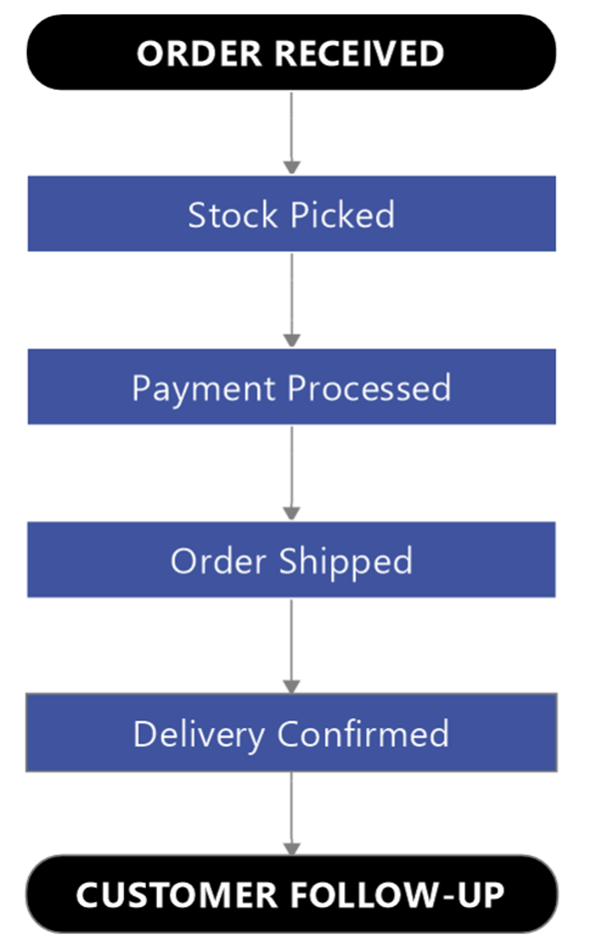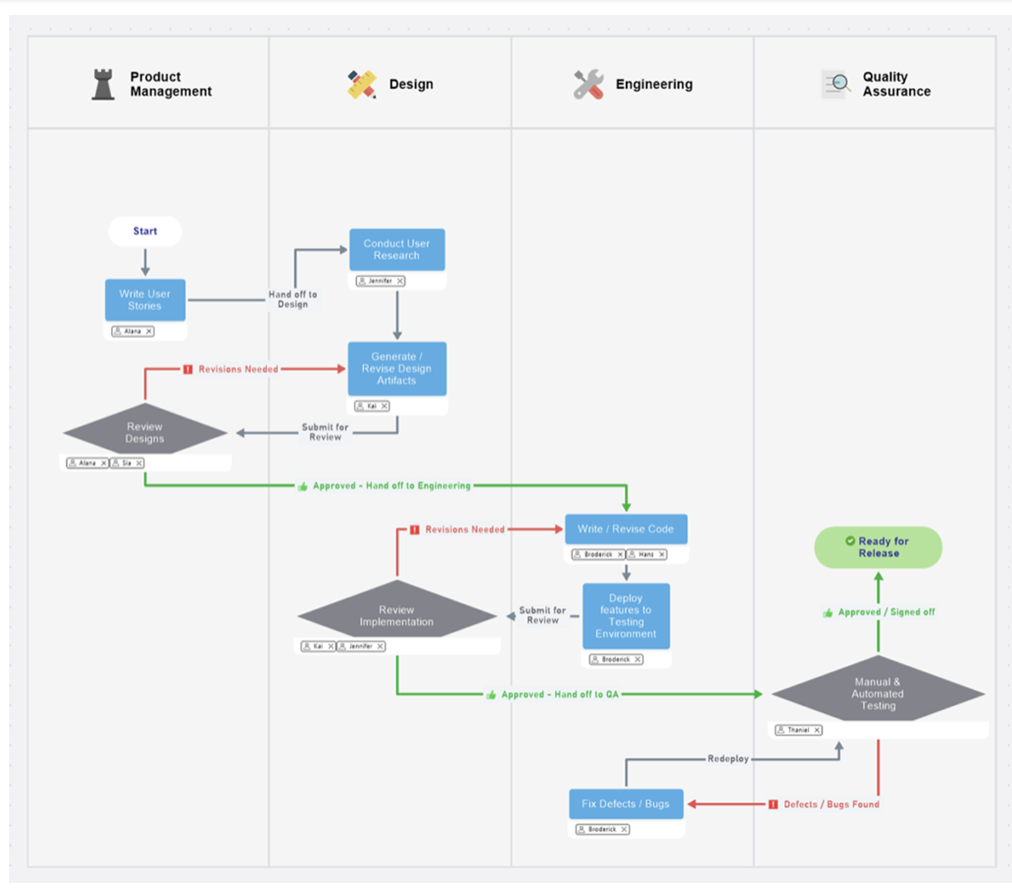In an ever-changing marketplace, it’s crucial for businesses to stay adaptable and continuously seek to improve their operational processes. But in order for an organization or team to seamlessly adjust to market conditions and implement process improvements, they must first understand how their existing processes actually work.
Business process documentation is the practice of outlining a business process in detail. Doing so helps teams better understand how their workflows are carried out and what can be done to improve them.
While business process documentation can be as simple as creating a list of written steps, it is more effective to leverage business process documentation software. Teams that use software to document their business processes are better equipped to reduce process errors, eliminate inefficiencies, streamline communications, and reduce operational costs.
In this article, we will explore the consequences of poor process documentation, the benefits of documenting organizational processes, how to properly document your organization’s business processes, and how to use software such as MindManager® to enhance the documentation process.
Consequences of poor process documentation
Process documentation provides teams and stakeholders with the information they need to do their job to the best of their ability. Without properly documented processes, organizations may fall victim to the following consequences:
Increase in human error. Human error is defined as a behavior carried out by a human being that causes intended results not to be achieved. When a business lacks documented procedures, it often leads to repeated occurrences of human error. Team members that are unsure of their roles and responsibilities tend to disengage from project processes, which can cause them to make costly mistakes that negatively impact their organization’s bottom line.
Excessive waste. Without clearly documented processes, it can be difficult for teams to utilize their project resources effectively. Allocating resources to waste activities can result in overspending, which can severely impact organizational revenue. Waste activities are unnecessary steps in company processes that add little value to the end product of a process and consume valuable resources. If a corporation is unable to effectively identify and eliminate waste activities, they will likely utilize more resources than necessary when facilitating projects, which proves detrimental to an organization’s bottom line.
Poor project outcomes. Lack of centralized process documentation often results in disorganized communications, which is not ideal when trying to ensure that stakeholders expectations are properly met at the end of a project. Without process documentation, teams tend to deviate from project requirements and are unable to hit key milestones. This can negatively impact project quality, and ultimately, prevent organizations from achieving their business goals.
Benefits of documenting organizational processes
Before we summarize how to properly document your organization’s business processes, let’s first take a look at some of the benefits of documenting company processes.
Reducing the risk of human error
When working as a team to accomplish organizational goals, human error is bound to occur. After all, humans aren’t perfect. This being said, to avoid overspending, teams must attempt to reduce human error as much as possible.
The best way to reduce human error is to document business processes in detail. This reduces workflow ambiguity by specifying which tasks must be accomplished over the duration of a process, and what order those tasks should be accomplished in.
Process documentation also serves as a resource for teams to reference over the duration of a project and even for future projects, minimizing confusion that often results in costly mistakes.
Eliminating process inefficiencies
Inefficient project processes can cost businesses valuable time, energy, and resources. This is precisely why it is important for companies to comprehensively document their business processes.
By documenting their processes in detail, teams can more effectively identify what tasks contribute value to their end goal and which do not. They can then use this information to eliminate waste activities from their project task list and allocate resources more effectively, aiding the continuous improvement of company processes.
Increasing the chance of project success
Process documentation helps ensure that all the necessary team members and stakeholders involved in a company project are consistently on the same page. Teams can leverage process documentation software that features processing mapping templates such as value stream maps and swim lane diagrams to increase process transparency.
Thorough documentation helps each person involved in a project understand what must be done to achieve project success. This ensures that project work is completed correctly the first time around since project requirements are abundantly clear.
How to properly document your organization’s business processes
At this point, you’re probably wondering how your organization should go about documenting their business processes. So, let’s explore a few of the best practices that top organizations often follow when outlining their company processes:
Prioritize collaboration during the document creation process. Business process documentation is a collaborative process. This means that all applicable individuals should be involved in outlining and updating the various steps of an existing company project. Some of these individuals may include project team members, internal stakeholders, and even external stakeholders that are invested in the company initiative at hand.
Maintain document accessibility. Process documents should serve as easily accessible resources for all individuals involved in a company project. After all, what’s the point of creating detailed process documentation if the appropriate stakeholders can’t access it? Document accessibility simply means that it can be easily shared and accessed by stakeholders when they need it, regardless of their physical location or platform of choice.
Regularly update documentation. After your teams successfully document their processes, the next step is to keep them up to date. The best way to do this is to create a revision schedule for your process documents. Revisions can occur on a daily, weekly, monthly, or quarterly basis. It simply depends on the changes that occur in your organization’s market environment. As soon as a process isn’t yielding the results expected, or opportunities for optimization are identified, be sure to implement and document changes.
Utilize visual diagrams. Visual diagrams are the key to comprehensive process documentation. Lengthy text-based explanations of company processes often fail to engage stakeholders in the same way that visualization tools do. Visual diagrams are a way to depict the activities that make up an existing company process in an eye-catching, easy-to-understand manner, ensuring that all diagram viewers truly understand the flow of work.
The most appealing aspect of using a visual diagram to map out company processes is that they can be as simple or complex as needed. From a simple process flowchart to a complex map identifying suppliers, inputs, outputs, and customers (SIPOC), there are all types of process maps that visually diagram how processes should be facilitated from start to finish.
The images below depict examples of both a simple process flowchart and a more complex swim lane diagram made with MindManager:

Simple process map made using MindManager

Swim lane diagram made with MindManager
How to use MindManager to enhance the business documentation process
When documenting processes, top organizations often opt to use mind mapping software applications like MindManager, as these types of solutions expand their ability to develop, share, and update their process documentation.
For instance, MindManager offers a large assortment of process mapping templates that can be collaboratively developed by multiple project stakeholders in real-time. This simplifies the documentation process, enabling key stakeholders to work together on process maps, regardless of their physical location.
MindManager also features a centralized dashboard that makes linking additional documentation within business process maps quite easy. Teams can use this feature to ensure that all business process documentation can be easily accessed by all appropriate stakeholders.
Not to mention MindManager seamlessly integrates with commonly used Microsoft Business applications such as Excel, Word, MS Project, and SharePoint. This feature enables teams to import Excel data, Word content, and other information directly from Microsoft applications into their process documents in MindManager.
Discover how MindManager is the solution to your business process documentation software needs.

